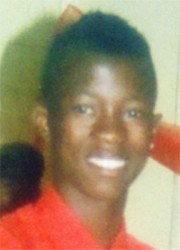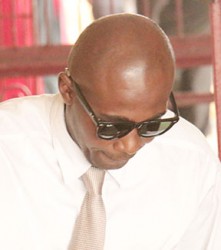The Shaquille Grant murder case was doomed from the beginning, persons close to it say, adding that they are not shocked at the recent outcome of the trial, since it was expected; however, his mother has vowed never to stop in her pursuit of justice.
The accused Terrence Wallace was freed last Thursday after he was found not guilty by a jury which came to this conclusion after deliberating for about two and a half hours.
Grant, 17, was fatally shot by police at Agricola, East Bank Demerara on September 11, 2012. The teen was among a group of young men under a shed in a yard who the police alleged were planning a robbery.

Almost a month later murder charges were laid against Wallace, Lance Corporal Warren Blue and Special Constable Jamal Lewis. However, only Wallace appeared and the court subsequently issued arrest warrants for the duo. While Lewis remains at large, Blue was shot and killed during a botched robbery on the East Coast Demerara.
A distraught Shonette Adams, who was present every day of the High Court trial which began on May 6, vowed that she will not rest until she gets justice for her son. She expressed optimism that she will get it under this new government and she said she will work on meeting President David Granger and Attorney General Basil Williams. “I will do whatever it takes to investigate that case cause my son’s death I strongly believe was ordered…,” she said adding before calling the three charged over the death “executioners.”
Adams expressed unhappiness with the evidence given, adding that a lot of lies were told during the hearings.
While calling for a private investigation into the death, she insisted that this is probably the only way for her to get to the truth. “I must get justice for Shaquille…. Don’t try to tell me Jamal Lewis is responsible. Warren Blue is responsible. All [three] officers were charged with murder. All three shots were fatal. My son’s testicles was on the ground’”, she stressed, her voice streaked with emotion.

She made reference to the testimony of government pathologist Dr Nehaul Singh that the shot her son received to the buttocks would not have been the fatal one, saying that she knew of a person who sustained such a similar injury and died a few hours later. Dr Singh had testified during the trial that the shot to Grant’s head or the one to his chest could have been fatal. The third wound, he testified, was one to the buttocks and it would not have resulted in death with any degree of immediacy, since it was not located in the region of any vital organs.
Adams said she was unimpressed with those chosen to sit on the jury. “I thought that jury use to be people sitting straight up, serious and listening. When I look at the jury frankly speaking, some people singing, some people whispering and they cannot be whispering about the things going on,” she said. “When you look at it, it was just a set of people selected to go on a lime and you get pay for the lime. That is what how I see it.”
She stressed that the prosecution did all it could and did a good job with the information given but “God is in charge.” She expressed views on who ordered her son killed adding that “something is definitely wrong” with the force given the fact that officers travelled to Agricola without seeking permission from their superiors or the police operations room.
“It’s a whole cook but they ain’t got no cook up if God ain’t cook it and all who fo get jail will get jail and some of them might get heart attack,” she said.
During the trial 20 witnesses testified, the bulk of whom were policemen.
It has always been said that police ought not to be investigating crimes committed by their colleagues.
‘Messed up’
A source close to the case told Stabroek News that based on everything that happened during the preliminary inquiry and the trial, “the case was messed up from the beginning.” The source said it would appear that there was deliberate interference to ensure that those charged would not be held responsible.
“This case was compromised because the police officers investigated their own and that should not be,” the source said while noting that a lot of what had been said during the trial made little sense.
The source pointed out that the discovery of two spent shells linked to weapons used by the other two accused and the failure of the police to locate the warheads which killed Grant, “does not make sense.” Further the source said the “disappearance” of those shells raised further questions and led to suspicion that there was some sort of “arrangement” or “collusion” involved so as to get a desired outcome.
The post-mortem examination had revealed that Grant died from three bullet wounds, one each to the thigh, chest and forehead. However, the source said, the police who said they processed the crime scene almost immediately after the shooting did not find the three warheads which exited the teen’s body. Instead they found two spent shells.
The prosecution’s case was that Wallace had ordered Grant and his friends—Romel Bollers, Nicholas Eastman, Jamal Henry called, “Tuna,” and Troy Greenidge—to lie on the ground and while complying Bollers began removing his cell phone from his pocket. At once, there was a bang, which appeared to be a gunshot.
Senior State Counsel Judith Gildharie-Mursalin who prosecuted the case had said in her opening address that Bollers was shot to the head, while Grant was heard saying, “Officer, officer, I get shoot.” She said that what appeared to be other gunshots rang out and following the shooting Bollers was injured and Grant was dead.
The court had heard from Gildharie-Mursalin that according to the police’s version, Bollers was attempting to run away from them and while doing so he had discharged a round at them from a weapon which he had. “The officers claimed that the action by Bollers was the catalyst for their shooting,” Gildharie-Mursalin had said.
However, Superinten-dent of Police and forensic analyst Stephen Greaves in his testimony said that he found no traces of gun powder residue on the hands of Bollers, Grant or any of the others. Gun powder residue would have suggested that the person had recently fired a weapon.
Constable Shawn Critchlow, the crime scene rank who processed and photographed the scene where Grant was killed, had previously testified that he had taken swabbed samples from Grant and his friends.
Critchlow had told the court that he had recovered spent shells from the scene. These items and the swabbed samples were, however could not be tendered as evidence since Critchlow said he could not find them.
According to the source, the testimony of the police was inconsistent with some of what was said by civilian witnesses, one of whom has “disappeared.” The witness, Greenidge, vanished without a trace in October last year. His relatives have not heard from him since and a missing person’s report has been lodged with the police.
The source noted too that the decision Wallace took to go against protocol is disturbing. While giving sworn testimony, the cop had said that his cousin, Travis David, had called and told him that a group of young men were in his (David’s) yard. Wallace, who was at the time performing patrol duties in the Kitty area, told the court that after speaking with his cousin he contacted other ranks from other patrols and they all went to the Agricola location. He and the other ranks were all uniformed, he said.
Wallace told the court that when he got to Agricola, he saw the young men under a shed in the yard and, with his firearm in hand, he shouted, “Freeze! Police!”
He said when he shouted, Bollers drew a gun from the waist of his pants and fired once in his direction as he attempted to run. Wallace added that he immediately returned fire by shooting one round in Bollers’s direction and the young man came to a halt and dropped his firearm next to his feet then knelt on the ground and placed his hands on his head.
According to the accused, almost at the same time there were two loud explosions of gunshots from behind him. “I could not say which of the ranks discharged the fire,” he said.
Wallace added that as he heard those subsequent shots, he saw one of the youngsters, whom he later learnt to be Grant, fall to the ground. Later, he observed injuries to the teen’s face.
He told the court that Bollers complained shortly after of being shot to the back of the head.
There was no indication as to whether Bollers was shot before or after the two loud explosions were heard. There is a belief that he was shot before and that bullet also struck Grant. This would account for the third bullet wound the teen sustained.
The source said too that based on the locations of the wounds it is clear that the bullets came from three different weapons as the entry came from three different angles.
“This whole story don’t add up,” the source stressed adding that “people are in a state of shock. It is not an easy thing.”
According to the source, it is unfair for the prosecutors to be blamed when the desired outcome in a case is not achieved. It was pointed out that prosecutors always have to work with the information gathered by the police which in many instances is lacking and inconsistent. “There are plenty times when the prosecutors try their best with next to nothing evidence, but cases will never be won if police do not do proper investigative work. Prosecutors are not investigators. The responsibility is on the police to go good work. To do good investigation. To do good evidence gathering,” the source stressed.
Stabroek News has since learnt that the state has not appealed the verdict in the Grant’s case. It is unclear if this will be done.





